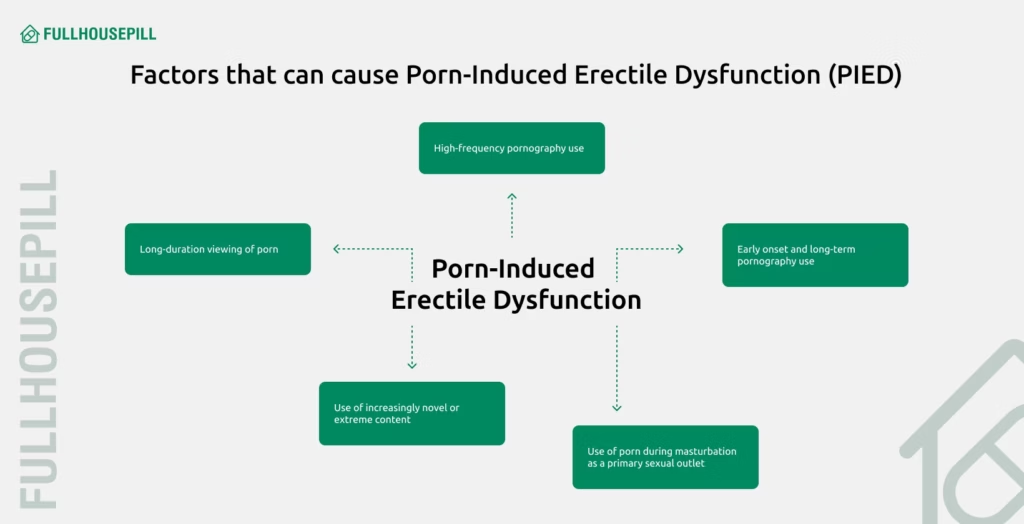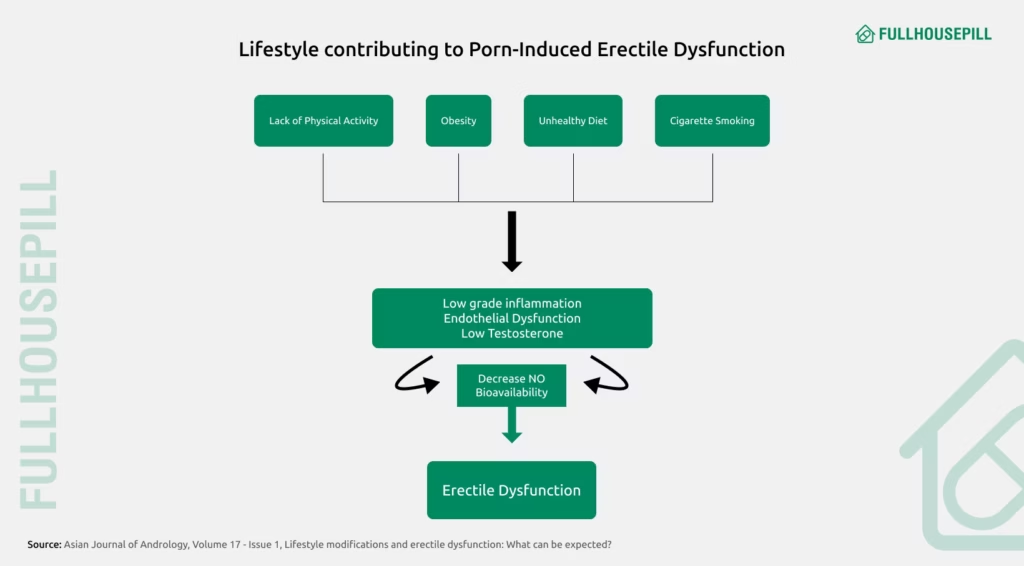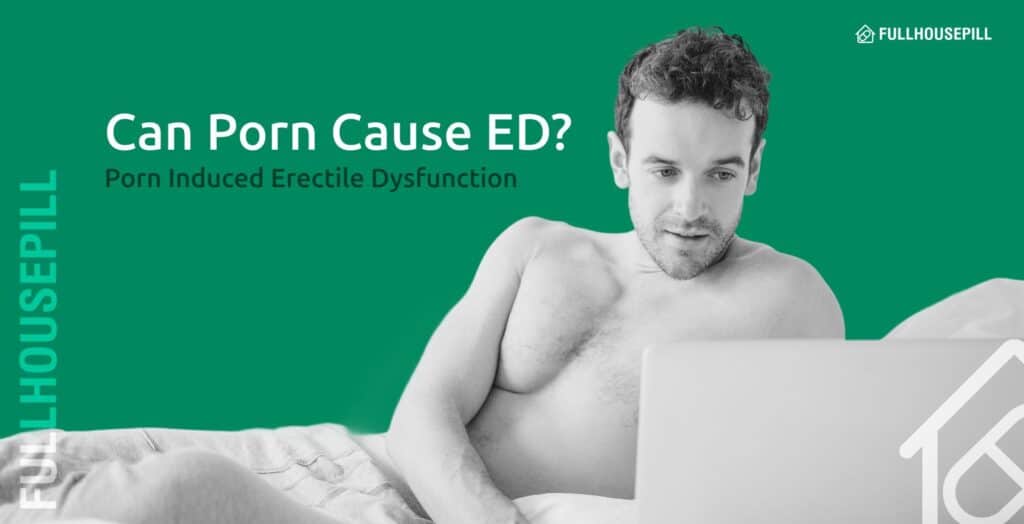Porn-Induced Erectile Dysfunction (PIED) refers to difficulty in achieving or maintaining an erection during partnered sex, despite normal erectile function while consuming pornography. It is increasingly linked to the compulsive use of internet-based erotic content, which over-stimulates the brain. The constant novelty and accessibility of online porn stimulate the brain with dopamine, a key neurotransmitter in sexual arousal and motivation. Over time, this repeated stimulation leads to desensitization, where natural sexual cues (such as physical intimacy with a partner) no longer elicit the same arousal response. Although not officially recognized in diagnostic manuals, PIED has become a topic of concern, particularly among young men.
Scientific studies suggest that excessive pornography use rewires neural circuits associated with reward and motivation, leading to reduced responsiveness to real-life sexual encounters. For example, research published in Behavioral Sciences and JAMA Psychiatry has shown that heavy porn consumption often changes the brain structure and function, especially in areas related to sexual stimulation and desire. These neurological shifts may be compounded by internet addiction and compulsive masturbation habits, which further weaken sexual performance with partners. Moreover, many users report increased anxiety, unrealistic expectations, and emotional distancing from real-life intimacy, which also contributes to erectile difficulties.
However, the scientific debate on PIED remains ongoing. Critics point out that most available research is correlational and often based on self-reported data, which cannot prove that pornography use directly causes erectile dysfunction. A systematic review published in Behavioral Sciences (2016) highlighted an important limitation in the current research on porn-induced ED. It noted that other factors, such as stress, anxiety, relationship difficulties, or hormonal imbalances, may also contribute to erectile dysfunction. This suggests that pornography may not be the sole or primary cause in many cases.
Still, many experts acknowledge the possible role of dopamine dysregulation, desensitization, and internet addiction in shaping sexual behavior. While causality is not fully established, the growing body of evidence points toward a link between compulsive porn use and sexual dysfunction in otherwise healthy individuals.
What Is Porn-Induced Erectile Dysfunction?
Porn-Induced Erectile Dysfunction (PIED) is a condition in which an individual, most often a man, struggles to achieve or sustain an erection during real-life sexual encounters, yet has no such difficulty when watching pornography. This phenomenon is increasingly discussed in connection with excessive exposure to internet pornography, often paired with compulsive masturbation.
While not yet formally recognized as a clinical diagnosis in major medical manuals (e.g., DSM-5), growing anecdotal reports and emerging studies have prompted significant scientific debate. Researchers theorize that repeated exposure to highly stimulating pornographic content may condition the brain to respond primarily to artificial stimuli, weakening arousal and performance in real-life intimacy. As awareness grows, PIED is becoming a focal point for both clinical inquiry and public health discussions around digital sexual behavior.
Can Porn Cause ED?
The relationship between pornography use and erectile dysfunction (ED) has become a growing topic of interest in sexual health research. While not all pornography users experience erectile dysfunction (ED), evidence is growing. An increasing number of studies suggest that excessive and compulsive consumption, particularly of high-speed internet pornography, may impair erectile function. This effect is especially noted in younger, otherwise healthy men. Excessive porn consumption can lead to dopamine desensitization, which may reduce sexual responsiveness and contribute to erectile dysfunction (ED).The key factors linked to this risk include frequency of use, duration over time, and exposure to increasingly unrealistic sexual stimuli.

A study published in JMIR Public Health and Surveillance (2021) examined 3,419 men aged 18-35 and found that 21.5% of sexually active participants reported some degree of erectile dysfunction (ED). Higher scores on the Cyber Pornography Addiction Test (CYPAT) were significantly associated with ED, even after adjusting for relationship issues and performance anxiety. Longer porn viewing sessions (over 30 minutes) and low relationship satisfaction were also linked to a higher risk of ED.
Another study, published in JAMA Psychiatry (2014), investigated how frequent pornography consumption affects the brain’s structure and function. Using brain scans of 64 healthy men aged 21 to 45, researchers found that those who watched more porn had less gray matter in the right caudate of the brain, lower brain response to sexual images, and weaker connections between reward and control regions of the brain. These changes are similar to patterns seen in addiction. However, since the study was cross-sectional, it did not link porn directly to these brain changes. Further studies are required for conclusive proof.

What Are the Signs and Symptoms of Porn-Induced ED?
Porn-Induced Erectile Dysfunction (PIED) manifests in several ways, often affecting men who engage in frequent or compulsive pornography use. Difficulty achieving or maintaining erections, especially during partnered sex but not during solo porn use, is a key sign of porn-induced erectile dysfunction (PIED). While other symptoms vary, they typically involve a disconnect between arousal during solo porn use and real-life sexual activity.
Below is a list of the symptoms experienced by men suffering from PIED.
- Difficulty achieving or maintaining erections during partnered sex.
- Stronger arousal to porn than to real-life partners.
- Delayed ejaculation or inability to climax without porn.
- Need for increasingly extreme or novel porn to become aroused.
- Flatline phase (temporary loss of libido after quitting porn).
- Anxiety, guilt, or shame related to sexual performance or porn habits.
- Compulsive porn use despite negative effects on sex life or relationships.
A study published in Military Medicine (2019) surveyed 20 to 40-year-old men presenting at a urology clinic to examine links between pornography preferences and erectile dysfunction (ED). Using the International Index of Erectile Function (IIEF) and measures of pornography use, the researchers found no correlation between ED and addiction-related factors like craving or obsessive passion. However, men who preferred masturbating with pornography over partnered sex had significantly higher rates of ED, nearly 80%, compared to about 22% among those favoring partnered sex without porn. The findings suggest that a preference for solo porn use is strongly associated with ED, independent of addiction severity.

Reduced sexual desire for real-life intimacy has been linked to frequent pornography use. A study published in the Journal of Sex & Marital Therapy (2014) surveyed 596 heterosexual men (avg. age 40) in relationships who reported decreased sexual desire. The researchers found that 67% masturbated at least weekly, and among those, 70% used pornography regularly. Using regression analysis, they determined that sexual boredom, frequent porn use, and low relationship intimacy were significant predictors of frequent masturbation. A review in the African Journal of Biomedical Research (2024), observed that pornography consumption is linked to decreased sexual desire in men, often accompanied by compulsive patterns.
Delayed ejaculation or performance anxiety may be linked to problematic pornography use. A study published in Archives of Sexual Behavior (2021) examined self-perceived problematic pornography use in over 1,539 adults (72.6% male) in Germany. Using a questionnaire based on DSM-5 addiction criteria, the study found that about 6% met the threshold for problematic use. These individuals spent more time watching porn and reported much higher levels of psychological distress. The study concluded that problematic porn use is strongly linked to mental health issues and should be considered in clinical assessments.
Is PIED Different From Other Types of Erectile Dysfunction?
Yes, porn-induced erectile dysfunction (PIED) is distinct from other common forms of erectile dysfunction (ED), namely organic and psychogenic ED, although it shares features with both. PIED is primarily a behavioral and arousal-related dysfunction, where the brain becomes conditioned to respond sexually to pornography rather than real-life intimacy. It typically affects younger men with no underlying medical issues and is strongly associated with excessive porn use, dopamine desensitization, and exposure to unrealistic sexual stimuli.
In contrast, organic ED is caused by physical factors, like cardiovascular disease, diabetes, hormonal imbalances, or nerve damage. It tends to occur more frequently in older men and often develops gradually. Organic ED usually persists across all sexual contexts, including during masturbation and porn viewing. Medical tests (e.g., hormone levels, nocturnal erections) often identify its root cause.
Psychogenic ED, on the other hand, arises from mental health issues like anxiety, stress, depression, or relationship problems. It appears suddenly and may vary with emotional state or partner dynamics. While PIED also involves psychological elements, such as performance anxiety, it is unique in that arousal is disrupted by porn-related conditioning, not just emotional distress.
Now that the differences are defined, read more below about the treatment methods for PIED.
How Is Porn-Induced ED Treated?
Porn-induced erectile dysfunction (PIED) often stems from disrupted arousal patterns linked to excessive pornography use. Addressing this condition typically involves behavioral, psychological, and lifestyle-based approaches. Find a detailed list below on the treatment methods for PIED.
- Porn Abstinence (Reboot)
Porn abstinence, commonly referred to as a “reboot,” is one of the most recommended treatments for porn-induced erectile dysfunction (PIED). This process, popularized by the NoFap movement, aims to reset the brain’s reward system and improve real-life sexual function. The goal is to allow the brain to reset its natural arousal patterns by avoiding pornography, fantasy, and even excessive masturbation. A review published in the Journal of Restorative Medicine (2019) highlights that abstaining from porn reverses the neuroplastic changes caused by overstimulation of the dopamine system. It notes that while some men recover in 2 months, those with long-term or early exposure may require up to 5 months for full recovery.
Supporting this, a study in Archives of Sexual Behavior (2021), analyzed reboot journals from men attempting porn abstinence. The study found a typical recovery process that included an initial spike in libido, a “flatline” phase (marked by low desire), and a gradual return of spontaneous erections and arousal during partnered sex. While results varied, most participants reported significant improvement within 8-12 weeks of sustained abstinence.
- Cognitive Behavioral Therapy
Cognitive Behavioral Therapy (CBT) is a structured, goal-oriented form of psychotherapy that helps individuals identify and change negative thought patterns and behaviors. CBT helps reduce compulsive porn use, manage performance anxiety, and reshape unrealistic sexual expectations to support healthier sexual function.
Early randomized trials, published in The Journal of Sexual Medicine (2007), demonstrated that integrating Cognitive Behavioral Therapy (CBT) with sildenafil led to higher success rates in sexual performance and satisfaction compared to medication alone, underscoring CBT’s role in treating the psychological roots of PIED. CBT has shown significant benefits for treating porn-induced erectile dysfunction (PIED) by addressing the underlying psychological patterns and anxiety that maintain the condition.
A recent pilot study in The Journal of Sexual Medicine (2020) evaluated cognitive behavioral sex therapy (CBST) in young men diagnosed with nonorganic ED, a category that includes PIED. Over 4-12 weeks of CBST, participants showed notable improvements in erectile function compared to those taking sildenafil alone, with enhanced outcomes in sexual satisfaction and reduced depressive symptoms.
- Medications
While the core issue in PIED is neurological rather than vascular, traditional erectile dysfunction medication like PDE5 inhibitors (e.g., sildenafil, tadalafil) temporarily aid performance when other strategies are in place. These medications work by increasing blood flow to the penis, helping to achieve and maintain erections. Clinical evidence shows PDE5 inhibitors effectively improve erectile function across a range of causes, including non-organic cases similar to PIED. However, experts caution that these medications do not address the underlying dopamine desensitization or arousal conditioning that characterizes PIED, meaning they are helpful, but not standalone solutions.
To achieve lasting recovery, erectile dysfunction medication is most effective when used as part of a multimodal treatment plan. Studies demonstrate that combining PDE5 inhibitors with Cognitive Behavioral Therapy (CBT), porn abstinence, and lifestyle improvements enhances long-term outcomes. For instance, a study in The Journal of Sexual Medicine (2019) found that combining a PDE5 inhibitor (like sildenafil) with Cognitive Behavioral Therapy (CBT) was more effective for treating erectile dysfunction than either treatment alone. The combined approach improved sexual function and reduced anxiety and depression more sustainably.
- Lifestyle Changes
Lifestyle changes are a foundational component of treating PIED, as they address overall physical and psychological health, both critical to sexual recovery. Research consistently shows that adopting healthier habits like regular exercise, quality sleep, reduced screen time, stress management, and a balanced diet can significantly improve erectile function. markedly improves erectile function, even in cases linked to porn use by restoring vascular health, hormone balance, and mental well-being.
A review published in Asian Journal of Andrology (2015) examined how adopting healthier lifestyle changes, like improved diet, increased physical activity, weight loss, stopping smoking, and reducing alcohol intake, improves erectile function. These behaviors reduce inflammation and enhance nitric oxide availability, which is crucial for healthy erections. By addressing general vascular and hormonal health, lifestyle changes complement strategies like reducing problematic porn use, which targets the neurological and behavioral components of PIED.

How Long Does It Take To Recover From PIED?
Recovery from porn-induced erectile dysfunction (PIED) can take anywhere from a few weeks to several months, depending on individual factors. Key influences include age, duration and intensity of porn use, frequency of masturbation, and overall physical and mental health. Younger men and those with healthier lifestyles often recover faster. During recovery, some may experience temporary challenges like mood swings, low libido, or a “flatline” phase. These are normal signs of the brain readjusting. With consistent effort, reduced porn use, and healthy habits, most men see steady improvement in sexual function over time.
Is PIED Permanent or Reversible?
Porn-Induced Erectile Dysfunction (PIED) is usually not permanent and is considered reversible in most cases. Since it primarily stems from psychological and behavioral factors, like excessive porn use and dopamine desensitization, reducing or quitting pornography allows the brain’s arousal system to recover. This process, often called “rebooting,” helps restore natural sexual response over time.
Many men report noticeable improvements in erections and sexual satisfaction within weeks to a few months. However, those facing deeper issues like internet addiction, anxiety, or depression may require professional support. With consistent lifestyle changes and, if needed, therapy, most individuals experience a full recovery.
When Should Someone Seek Professional Help for PIED?
Professional help should be sought if erectile issues persist and affect relationships, self-esteem, or mental health. Signs like difficulty getting erections even during masturbation, compulsive porn use, or symptoms of anxiety or depression warrant attention. A doctor can rule out physical causes, while therapy can address psychological and behavioral factors linked to PIED. Early intervention often leads to better outcomes and healthier sexual functioning.
Is It Normal To Rely On Porn To Get An Erection?
Relying on porn for arousal can signal pornography-induced erectile dysfunction (PIED). While occasional porn use is normal, consistent reliance for erections may desensitize your brain to real-life intimacy. This can create a higher arousal threshold, disrupt emotional connection, and impair your ability to get or keep an erection with a partner. PIED is often linked to conditioning, anxiety, low self-esteem, or compulsive behaviors. Reducing porn exposure, exploring alternative arousal sources, and seeking therapy are recommended if dependency or erectile issues occur.
What Are The Reasons For Losing An Erection?
Losing an erection can result from health conditions, emotional stress, or certain medications. Men often experience this issue due to a mix of physical and psychological causes. Chronic illnesses like diabetes and cardiovascular disease impair blood flow, which is critical for maintaining an erection. Hormonal imbalances, such as low testosterone, also play a role. Lifestyle habits like smoking or drinking alcohol excessively further reduce vascular function. Medications including SSRIs and blood pressure drugs are known contributors. Psychological triggers, such as performance anxiety or unresolved relationship conflict, can intensify the risk. Men worried about losing erection during sex should consult a healthcare provider to identify the underlying cause.
How to get hard and get a stronger erection?
Improving blood flow, hormone levels, and psychological readiness is key to achieving a stronger erection.
- Exercise regularly
Cardiovascular workouts like brisk walking, swimming, or cycling improve blood circulation, which is essential for firm erections. Strong heart health supports blood flow to the penis during arousal. - Eat foods for stronger erection support
Certain foods enhance nitric oxide production, a key compound for relaxing blood vessels in the penis. Spinach, beetroot, and watermelon are rich in nitrates, while dark chocolate and pomegranate offer flavonoids. These are proven stronger erection foods that naturally boost function. - Reduce porn use
Overreliance on visual stimulation can desensitize the brain’s arousal response. Cutting down on porn helps retrain the body to respond to real-life intimacy. - Limit alcohol intake
Excessive alcohol interferes with nerve signals and hormone levels. Moderate or minimal alcohol use is more compatible with healthy sexual performance. - Manage stress and sleep
Chronic stress elevates cortisol, which suppresses testosterone. Quality sleep (7–8 hours) helps restore hormone balance and mental focus. - Lose weight and quit smoking
Obesity reduces testosterone and impairs blood flow. Smoking damages blood vessels and increases the risk of erectile dysfunction. A healthier body improves sexual stamina and confidence. - Train your pelvic floor muscles
Kegel exercises strengthen the muscles involved in erection and ejaculation. Consistent training can improve hardness and control. - Consider medical treatment
When lifestyle changes aren’t enough, medications like sildenafil or tadalafil may be prescribed. These PDE5 inhibitors enhance blood flow and responsiveness to sexual stimulation.
How does age affect the erection?
Erectile strength typically declines with age due to vascular, hormonal, and neurological changes. Blood vessels lose elasticity over time, making it harder to maintain optimal blood flow to the penis. Testosterone levels begin to decline as early as the 30s, which can reduce libido and arousal. Many men also experience reduced nerve sensitivity and slower response times. These biological changes are often compounded by chronic health conditions such as hypertension or diabetes. While aging does not automatically mean loss of sexual function, the age at which men stop getting hard varies depending on lifestyle, genetics, and health. Proper diet, exercise, and medical care can help preserve erectile function well into later years.
